Chapter 5
Keeping Track of Layers and Blocks
Imagine a filing system that has only one category into which you put all your records. For only a handful of documents, such a filing system might work. However, as soon as you start to accumulate more documents, you would want to start separating them into meaningful categories, perhaps alphabetically or by their use, so you could find them more easily.
The same is true for drawings. If you have a simple drawing with only a few objects, you can get by without using layers. But as soon as your drawing gets the least bit complicated, you’ll want to start sorting your objects into layers to keep track of what’s what. Layers don’t restrict you when you’re editing objects such as blocks or groups, and you can set up layers so that you can easily identify which object belongs to which layer.
In this chapter, you’ll learn how to create and use layers to keep your drawings organized. You’ll learn how color can play an important role while you’re working with layers, and you’ll also learn how to include linetypes such as dashes and center lines through the use of layers.
In this chapter, you’ll learn to do the following:
- Organize information with layers
- Control layer visibility
- Keep track of blocks and layers
Organizing Information with Layers
You can think of layers as overlays on which you keep various types of information (see Figure 5-1). In a floor plan of a building, for example, you want to keep the walls, ceiling, plumbing fixtures, wiring, and furniture separate so that you can display or plot them individually or combine them in different ways. It’s also a good idea to keep notes and reference symbols, as well as the drawing’s dimensions, on their own layers. As your drawing becomes more complex, you can turn the various layers on and off to allow easier display and modification.
For example, one of your consultants might need a plot of just the dimensions and walls, without all the other information; another consultant might need only a furniture layout. Using manual drafting, you would have to redraw your plan for each consultant or use overlay drafting techniques, which can be cumbersome. With AutoCAD, you can turn off the layers you don’t need and plot a drawing containing only the required information. A carefully planned layering scheme helps you produce a document that combines the types of information needed in each case.
Using layers also lets you modify your drawings more easily. For example, suppose you have an architectural drawing with separate layers for the walls, the ceiling plan, and the floor plan. If any change occurs in the wall locations, you can turn on the ceiling plan layer to see where the new wall locations will affect the ceiling and then make the proper adjustments.
Figure 5-1:Placing drawing elements on separate layers
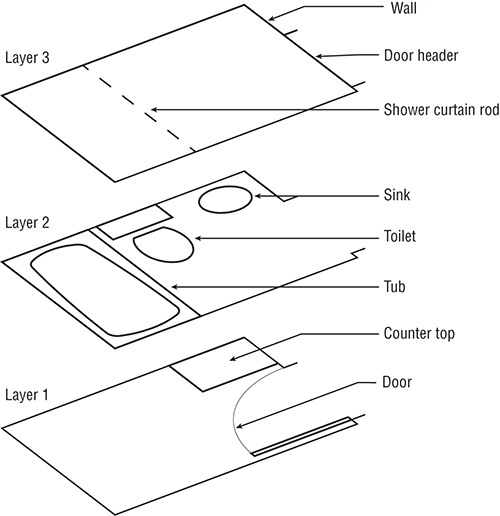
AutoCAD allows an unlimited number of layers, and you can name each layer anything you want using any characters with the exception of these: < > / “ ” : ; ? * | , = ‘ ’.
Creating and Assigning Layers
You’ll start your exploration of layers by using the Layers palette and the Properties Inspector palette to create a new layer, giving it a name, and assigning it a color. Then, you’ll look at alternate ways of creating a layer through the command line. Next, you’ll assign the new layer to the objects in your drawing. Start by getting familiar with the Layers palette:
1. Open the Bath file you created in Chapter 4, “Organizing Objects with Blocks and Groups.” (If you didn’t create one, use either 04b-bath.dwg or 04b-bath-metric.dwg, available on the book’s website, www.sybex.com/go/masteringautocadmac.)
Take a look at the Layers palette. It shows you at a glance the status of your layers. Right now, you have only one layer, a layer named 0, but as your work expands, so will the number of layers. You’ll then find this palette indispensable (Figure 5-2).
2. Click the plus icon at the bottom left of the palette.
A new layer named Layer1 appears in the list box. Notice that the name is highlighted. This tells you that, by typing, you can change the default name to something better suited to your needs.
Figure 5-2:The Layers palette

3. Type Wall↵. As you type, your entry replaces the Layer1 name in the list box.
4. Click the name Wall to select it.
5. Take a look at the Properties Inspector palette. You’ll see the properties of the selected layer.
6. In the Properties Inspector palette, click and hold the Color list to open the pop-up list of colors (Figure 5-3).
Figure 5-3:The Properties Inspector palette showing the Color option and pop-up list

7. Choose the Select Color option at the bottom of the list and release the mouse button.
The Color Palette dialog box opens (Figure 5-4).
8. In the row of standard colors to the left of the ByLayer button, click the green square, and then click OK. Notice that the color swatch in the Wall layer listing is now green.
Figure 5-4:The Color Palette dialog box

You could have selected a color from the Color pop-up list, but by using the Select Color option, you were introduced to the Color Palette dialog box.
From this point on, any object assigned to the Wall layer will appear green unless the object is specifically assigned a different color.
I’d like to point out another method for setting layer colors. In addition to using the Properties Inspector palette, you can set the layer color using the Color column in the Layers palette. The Color column is the one with the square icon (Figure 5-5).
Figure 5-5:The layer color can be set in the Color column of the Layers palette.

When a layer is assigned a color other than white, the color is displayed in this column. You can click this column to open a pop-up menu that offers the same color options you saw in the Properties Inspector palette.
Using the Properties Inspector Palette to Set Layer Options
Now let’s take a closer look at how the Properties Inspector palette interacts with the Layers palette. In Chapter 4, you saw how the Properties Inspector palette displays information about objects in your drawing. When you click on a layer in the Layers palette, the Properties Inspector palette displays the properties of the selected layer. Try the following to see firsthand how this works:
1. In the Layers palette, click the layer 0 under the Name column and watch what happens in the Properties Inspector palette. You see detailed information about layer 0.
2. Click the Wall layer under the Name column in the Layers palette. Now information about the Wall layer is displayed in the Properties Inspector palette (Figure 5-6).
Figure 5-6:The Properties Inspector palette displays information about a selected layer.

The Properties Inspector palette offers several pop-up lists that enable you to change the layer properties such as color, linetype, and line weight. Layer transparency can be controlled with a slider. You used the Color pop-up list to select a color for the Wall layer in the previous exercise.
You’ll also want to know about the two icons in the upper-left corner of the Properties Inspector palette. They are labeled Current and Layer (Figure 5-7). These icons enable you to switch between displaying the properties of an object in the drawing and the current layer.
You’ll get a chance to use some of the other settings later in this chapter. Let’s continue with a closer look at some other layer features.
Figure 5-7:The Current and Layer icons in the Properties Inspector palette

Using True or PANTONE Colors
In an earlier exercise, you chose a color from the Index Color tab of the Color Palette dialog box. Most of the time, you’ll find that the Index Color tab includes enough colors to suit your needs. But if you’re creating a presentation drawing in which color selection is important, you can choose colors from either the True Color tab or the Color Books tab of the Color Palette dialog box.
The True Color tab offers a full range of colors through a color palette similar to the one found in Adobe Photoshop and other image editing programs (Figure 5-8).
Figure 5-8:The True Color tab

You have the choice of using hue, saturation, and luminance, which is the HSL color mode, or you can use the RGB (red, green, blue) color mode. You can select HSL or RGB from the Mode drop-down list in the upper-right corner of the dialog box (Figure 5-9).
Figure 5-9:The Mode drop-down list

You can also select from PANTONE, RAL, and DIC color books by using the Color Books tab (Figure 5-10). Color books are “books” that contain color samples with their corresponding number code. If you’ve ever gone to a paint store to select a color, chances are you’ve used one. In AutoCAD, the color books are displayed as a list of colors and codes.
Figure 5-10:The Color Books tab

Let’s continue with our look at layers in AutoCAD.
Understanding the Layers Palette
The most prominent feature of the Layers palette is the layer list box, as you saw in the preceding exercise. As you add them, the list box begins to fill up with layers. Notice that the bar at the top of the list of layers offers several buttons for the various layer properties. You can adjust the width of the Name column in the list of layers by clicking and dragging either side of the column head. You can also sort the layer list based on the name at the top of the list. And just as with other Mac list boxes, you can also click names to select a block of layer names, or you can F-click individual names to select multiple layers that don’t appear together. These features will become helpful as your list of layers grows.
You’ve already seen how the New Layer icon works. To delete layers, you select a layer or group of layers and then click the Delete Layer icon, which looks like a minus sign. Be aware that you can’t delete layer 0, locked layers, or layers that contain objects. You can also see at a glance which layer is the current drawing layer by the gray highlighted row in the layer list. Right now, layer 0 is highlighted in gray (Figure 5-11). This is the layer on which objects will be placed when you’re drawing in the drawing area.
Figure 5-11:The current drawing layer is highlighted in gray

Note that just clicking on a layer does not make it the current drawing layer. When you click on a layer to set its properties, it is highlighted in blue. If you click on the Wall layer, it will be highlighted in blue while layer 0 will continue to be highlighted in gray.
Another way to create or delete layers is to select a layer or set of layers from the list box and then right-click. A menu appears, offering additional options that you can apply to selected layers (Figure 5-12). Table 5-1 describes the function of these options.
Figure 5-12:A shortcut menu appears when you right-click a layer name in the Layers palette.
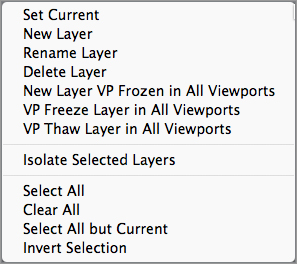
Table 5-1: The Layers palette shortcut menu options
| Option Name | Function |
| Set Current | Sets the selected layer to be the current drawing layer |
| New Layer | Creates a new layer |
| Rename Layer | Renames the selected layer |
| Delete Layer | Deletes the selected layer(s) with the option to delete its contents when objects are present on the layer |
| New Layer VP Frozen In All Viewports | Creates a new layer that is frozen in all viewports |
| VP Freeze Layer In All Viewports | Freezes selected layer(s) in all viewports |
| VP Thaw Layer In All Viewports | Thaws selected layers in all viewports |
| Isolate Selected Layers | Hides (turns off) all but the selected layer(s) in the drawing |
| Select All | Selects all the layers that are displayed in the layer list |
| Clear All | Clears the selection of layers in the layer list |
| Select All But Current | Selects all but the current layer |
| Invert Selection | Inverts the selection of layers in the list |
You’ll also notice another set of icons at the top of the Layers palette. Those icons offer features to control and manage layers. You’ll get a closer look at them a little later in this chapter in the section “Using Objects to Control Layers.”
Controlling Layers through the Layer Command
You’ve seen how the Layers palette makes it easy to view and edit layer information and how you can easily select layer colors from the Color Palette dialog box. But you can also control layers through the Command prompt.
Use these steps to control layers through the Command prompt:
1. Press the Esc key to make sure any current command is canceled.
2. At the Command prompt, enter –Layer↵. Make sure you include the minus sign in front of the word Layer. The following prompt appears:
Enter an option
[?/Make/Set/New/Rename/ON/OFF/Color/Ltype/LWeight/TRansparency/MATerial/
Plot/Freeze/Thaw/LOck/Unlock/stAte/
Description/rEconcile]:
If the Dynamic Input display is on, you’ll see these options appear at the cursor as a list. You’ll learn about many of the options in this prompt as you work through this chapter.
3. Enter N↵ to select the New option.
4. At the Enter name list for new layer(s): prompt, enter Wall2↵. The [?/Make/Set/New/Rename/ON/OFF/Color/Ltype/LWeight/TRansparency/MATerial/Plot/Freeze/Thaw/LOck/Unlock/stAte/rEconcile]: prompt appears again.
5. Enter C↵.
6. At the New color [Truecolor/COlorbook]: prompt, enter Yellow↵. Or, you can enter 2↵, the numeric equivalent of the color yellow in AutoCAD.
7. At the Enter name list of layer(s) for color 2 (yellow) <0>: prompt, enter Wall2↵. The [?/Make/Set/New/Rename/ON/OFF/Color/Ltype/LWeight/ TRansparency/MATerial/Plot/Freeze/Thaw/LOck/Unlock/stAte/rEconcile]: prompt appears again.
8. Press ↵ to exit the Layer command.
Each method of controlling layers has its own advantages. The Layers palette offers more information about your layers at a glance. On the other hand, the Layer command offers a quick way to control and create layers if you’re in a hurry. Also, if you intend to write custom macros and scripts, you’ll want to know how to use the Layer command as opposed to using the Layers palette because palettes can’t be controlled through custom macros or scripts.
Assigning Layers to Objects
When you create an object, that object is assigned to the current layer. Until now, only one layer has existed—layer 0—and it contains all the objects you’ve drawn so far. Now that you’ve created some new layers, you can reassign objects to them by using the Properties Inspector palette:
1. Select the four lines that represent the bathroom walls. If you have trouble singling out the wall to the left, use a window (click and drag from left to right) to select the wall line.
2. Make sure the Current icon is highlighted in the upper-left corner of the Properties Inspector palette. This causes the Properties Inspector palette to display the properties of the selected object or set of objects.
3. Click the Layer option on in the Properties Inspector palette. The list expands to show the current set of layers available.
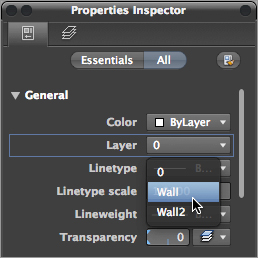
4. Select the Wall layer from the list. Notice that the wall lines you selected change to a green color. This tells you that the objects have been assigned to the Wall layer. (Remember that you assigned a green color to the Wall layer.)
5. Press the Esc key to clear the selection so you can see the wall more clearly.
The bathroom walls are now on the new layer called Wall, and the walls are changed to green. Layers are more easily distinguished from one another when you use colors to set them apart.
Next, you’ll practice the commands you learned in this section and try some new ones by creating new layers and changing the layer assignments of the rest of the objects in your bathroom:
1. Use the Layers palette to create a new layer called Fixture, and give it the color blue. Remember that after you create the layer, you need to select it in the Layers palette list before you can set its color in the Properties Inspector palette.
If you need to change the name of a layer in the Layers palette, select the layer name that you want to change and click it again so that the name is highlighted. You can then rename the layer. This works in the same way as renaming a file or folder in the Finder.
2. Click the Tub and Toilet blocks to select them, and then make sure that the Current icon is selected in the Properties Inspector palette.
3. In the Properties Inspector palette, click the disclosure triangle in the Layer option and select Fixture from the pop-up list that appears.
4. Press the Esc key to clear your selection.
For blocks, you can change the color assignment and linetype of only those objects that are on layer 0 within a block. See the sidebar “Controlling Colors and Linetypes of Blocked Objects” later in this chapter.
Continue by creating new layers and assigning objects to them:
1. Create a new layer for the door, name the layer Door, and make it red.
2. Just as you’ve done with the walls and fixtures, use the Properties Inspector palette to assign the door to the Door layer.
3. Use the Layers palette to create three more layers, one for the ceiling, one for the door jambs, and one for the floor. Create these layers, and set their colors as indicated (remember that you can open the Color Palette dialog box by selecting the Select Color option in the expanded Color option in the Properties Inspector palette):
| Layer Name | Color |
| Ceiling | Magenta (6) |
| Jamb | Green (3) |
| Floor | Cyan (4) |
Understanding Object Properties
It helps to think of the components of an AutoCAD drawing as having properties. For example, a line has geometric properties, such as its length and the coordinates that define its endpoints. An arc has a radius, a center, and beginning and ending coordinates. Even though a layer isn’t an object you can grasp and manipulate, it can have properties such as color, linetypes, and line weights.
By default, objects take on the color, linetype, and line weight of the layer to which they’re assigned, but you can also assign these properties directly to individual objects. These general properties can be manipulated through the Properties Inspector palette.
Although many of the options in the Properties Inspector palette may seem cryptic, don’t worry about them at this point. As you work with AutoCAD, these properties will become more familiar. You’ll find that you won’t be too concerned with the geometric properties because you’ll be manipulating them with the standard editing tools in the Tool Sets palette or the menu bar. The other properties will be explained in the rest of this chapter and in other chapters.
In step 2 of the previous exercise, you used the Properties Inspector palette, which offered several options for modifying the block. The options displayed in the Properties Inspector palette depend on the objects you’ve selected. With only one object selected, AutoCAD displays options that apply specifically to that object. With several objects selected, you’ll see a more limited set of options because AutoCAD can change only those properties that are common to all the objects selected.
Working on Layers
So far, you’ve created layers and then assigned objects to them. In this section, you’ll continue to use the Layer pop-up list in the Properties Inspector palette to assign layers to objects. In the process, you’ll make some additions to the drawing.
Controlling Colors and Linetypes of Blocked Objects
Layer 0 has special importance to blocks. When objects assigned to layer 0 are used as parts of a block and that block is inserted on another layer, those objects take on the characteristics of their new layer. On the other hand, if those objects are on a layer other than layer 0, they maintain their original layer characteristics even if you insert or change that block to another layer. For example, suppose the tub is drawn on the Door layer instead of on layer 0. If you turn the tub into a block and insert it on the Fixture layer, the objects the tub is composed of will maintain their assignment to the Door layer even though the Tub block is assigned to the Fixture layer.
It may help to think of the block function as a clear plastic bag that holds together the objects that make up the tub. The objects inside the bag maintain their assignment to the Door layer even while the bag itself is assigned to the Fixture layer. This may be a bit confusing at first, but it should become clearer after you use blocks for a while.
AutoCAD also enables you to have more than one color or linetype on an object. For example, you can use the Color and Linetype pop-up lists in the Properties Inspector palette to alter the color or linetype of an object on layer 0. That object then maintains its assigned color and linetype—no matter what its layer assignment. Likewise, objects specifically assigned a color or linetype aren’t affected by their inclusion in blocks.
The current layer is still layer 0, and, unless you change the current layer, every new object you draw will be on layer 0. Here’s how to change the current layer:
1. First press the Esc key to clear any selections.
2. Click the Jamb layer name in the Layers palette, right-click, and select Set Current from the shortcut menu. The Jamb layer in the layer list is highlighted indicating that Jamb is now the current layer.
You can also use the Layer command to reset the current layer. To do this here, enter –Layer↵ S↵ and then enter Jamb↵↵.
3. Zoom in on the door, and draw a 5˝ line; start at the lower-right corner of the door and draw toward the right. Metric users should draw a 13 cm line.
4. Draw a similar line from the top-right end of the arc. Your drawing should look like Figure 5-13.
Because you assigned the color green to the Jamb layer, the two lines you just drew to represent the door jambs are green. This gives you immediate feedback about which layer you’re on as you draw.
Figure 5-13:Door at wall with door jambs added

Now you’ll use the part of the wall between the jambs as a line representing the door header (the part of the wall above the door). To do this, you’ll have to cut the line into three line segments and then change the layer assignment of the segment between the jambs:
1. Click the disclosure triangle to open the Modify panel (Figure 5-14).
2. Click the Break At Point icon in the Modify panel.
3. At the Select object: prompt, click the wall between the two jambs.
Figure 5-14:Open the Modify panel.

4. At the Specify first break point: prompt, use the Endpoint Osnap override to pick the endpoint of the door’s arc that is touching the wall, as shown previously in Figure 5-13.
5. Click Break At Point on the Modify panel again, and then repeat steps 2 and 3, this time using the jamb near the door hinge location to locate the break point (see Figure 5-13).
Although it may not be obvious, you’ve just broken the right-side wall line into three line segments: one at the door opening and two more on either side of the jambs. You can also use the Break tool (to the left of the Break At Point tool) to produce a gap in a line segment.
The Break At Point icon won’t work on a circle. You can, however, use the Break tool, also on the Modify panel, to place a small gap in the circle. If you create a small enough gap, the circle will still look like a full circle.
Next you’ll change the Layer property of the line between the two jambs to the Ceiling layer. But instead of using the Properties Inspector palette as you’ve done in earlier exercises, you’ll use a shortcut method:
1. Click the line between the door jambs to highlight it. Notice that the layer listing in the Layers palette changes to highlight the Wall layer and the Properties Inspector palette shows the Wall layer for the selected line. Whenever you select an object to expose its grips, the Color, Linetype, Lineweight, and Plot Style listings in the Properties Inspector palette change to reflect those properties of the selected object.
2. Click the Layer option in the Properties Inspector palette to open the Layer pop-up list.
3. Select the Ceiling layer. The list closes and the line you selected changes to the magenta color, showing you that it’s now on the Ceiling layer. Also notice that the Color pop-up list in the Properties Inspector palette changes to reflect the new color for the line.
4. Press the Esc key to clear the grip selection. Notice that the layer returns to Jamb, the current layer.
5. Choose View Zoom Previous from the menu bar, or you can enter Z↵ P↵.
In this exercise, you saw that when you select an object with no command active, the object’s properties are immediately displayed in the Properties Inspector palette under Color, Linetype, and Lineweight. Using this method, you can also change an object’s color, linetype, and line weight independent of its layer. Just as with the Properties Inspector palette, you can select multiple objects and change their layers through the Layer pop-up list.
Now, you’ll finish the bathroom by adding a sink to a layer named Casework:
1. In the Layers palette, create a new layer called Casework.
2. With the Casework layer selected in the Layers palette, right-click and select Set Current.
3. In the Properties Inspector palette, click the Color option for Casework, and then select Blue from the pop-up list. Notice that the Layer list in the Layers palette indicates that the current layer is Casework.
Next you’ll add the sink. As you draw, the objects will appear in blue, the color of the Casework layer.
4. Choose View Zoom All from the menu bar, or type Z↵ A↵.
5. Click the Insert icon on Tool Sets palette, and then click the Browse button in the Insert Block dialog box to open the Select Drawing File dialog box.

6. Locate the sink.dwg file, and double-click it.
7. In the Insert dialog box, click Insert.
8. Place the sink roughly in the upper-right corner of the bathroom plan, and then use the Move command to place it accurately in the corner, as shown in Figure 5-15.
Figure 5-15:The bathroom with sink and countertop added

Controlling Layer Visibility
I mentioned earlier that you’ll sometimes want to display only certain layers to work with in a drawing. In this bathroom is a door header that would normally appear only in a reflected ceiling plan. To turn off a layer so that it becomes invisible, you click the On/Off icon in the Layers palette, as shown in these steps:
1. Click the Ceiling layer in the layer list.
2. Click the On/Off icon to the far left end of the Ceiling layer name. It looks like a white dot. If you don’t see the On/Off icon, use the scroll bar at the bottom of the Layers palette to scroll all the way to the left. Once you click the On/Off icon, it changes from a solid white dot to a black dot to indicate that the layer is off.
With the Ceiling layer off, the line representing the door header disappears.
Getting Multiple Uses from a Drawing Using Layers
Layering lets you use a single AutoCAD drawing for multiple purposes. A single drawing can show both the general layout of the plan and more detailed information such as equipment layout or floor-paving layout.
The following two images are reproductions of the San Francisco Main Library’s lower level and show how one floor plan file was used for two purposes. The first view shows the layout of furnishings, and the second view shows a paving layout. In each case, the same floor plan file was used, but in the first panel, the paving information is on a layer that is turned off. Layers also facilitate the use of differing scales in the same drawing. Frequently, a small-scale drawing of an overall plan will contain the same data for an enlarged view of other portions of the plan, such as a stairwell or an elevator core. The detailed information, such as notes and dimensions, might be on a layer that is turned off for the overall plan.

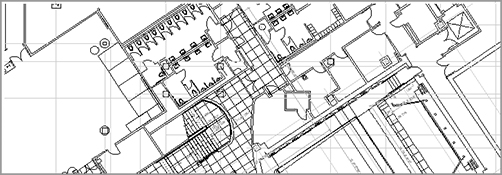
There are a few other icons and corresponding columns that appear with each of the layers in the layer list but they may be hidden from view. Use the scroll bar at the bottom of the Layer palette to scroll the list to the left. You’ll see three more icons. These are Freeze/Thaw, Lock/Unlock, Plot/No Plot (Figure 5-16).
The Freeze/Thaw column controls the visibility of layers in a way similar to the On/Off icon. The Lock/Unlock column locks a layer to prevent accidental edits to objects on the layer. The Plot/No Plot column enables you to control whether a layer appears in printed output or if it only appears in the drawing on the computer screen. All of these columns at the top of the layer list are duplicated in the Properties Inspector palette and the properties they control can be set in both places.
Figure 5-16:The Freeze/Thaw, Lock/Unlock/, Plot/No Plot, and VP icons
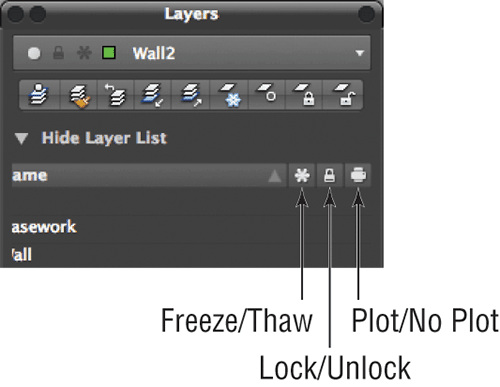
Adding Control Features to the Layer List
As mentioned earlier, the Properties Inspector palette duplicates some of the settings found in the layer list of the Layers palette. You can include more of the layer properties in the layer list by using the Layers palette’s Display Settings icon. Click the Display Settings icon to view the pop-up menu (Figure 5-17). You’ll see a list of options, some of which have a check mark next to them. The options with the check mark are the ones that already appear in the layer list.
Figure 5-17:The Display Settings icon found in the lower-left corner of the Layers palette
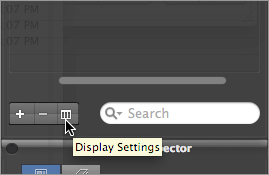
You can select an unchecked option to include it in the layer list. For example, if you select Status, a triangle marker appears in the layer list indicating the current layer.
The VP Freeze, VP Color, and VP Lineweight options are used when multiple viewports (VPs) are present. You’ll learn more about viewports in Chapter 8, “Introducing Printing and Layouts,” Chapter 15, “Laying Out Your Printer Output,” and Chapter 20, “Using Advanced 3D Features.” Viewports interact with layers in a unique way. A viewport is like a custom view of your drawing. You can have multiple viewports in a layout, each showing a different part of your drawing. Layer properties can be controlled for each viewport independently, so you can set up different linetypes, colors, and layer visibility for each viewport.
Toward the bottom of the list, you see three options that control the overall appearance of the list. Optimize All Columns compresses the columns to their smallest size, enabling you to see as many columns as possible within the layer list. Optimize Column adjusts the width of the columns so they fit comfortably within the width of the Layers palette. Restore All Columns To Defaults sets the columns to their default widths.
Finding the Layers You Want
With only a handful of layers, it’s fairly easy to find the layer you want to turn off. It becomes much more difficult, however, when the number of layers exceeds 20 or 30. The Layers palette offers some useful tools to help you find the layers you want quickly.
Suppose you have several layers whose names begin with C, such as C-lights, C-header, and C-pattern, and you want to find those layers quickly. You can click the Name button at the top of the layer list to sort the layer names in alphabetic order. (You can click the Name button again to reverse the order.) To select those layers for processing, click the first layer name that starts with C, and then scroll down the list until you find the last layer of the group and ![]() -click it. All the layers between those layers are selected. If you want to deselect some of those layers, hold down the F key while clicking the names of the layers you don’t want to include in your selection. Another option is to F-click the names of other layers you want selected.
-click it. All the layers between those layers are selected. If you want to deselect some of those layers, hold down the F key while clicking the names of the layers you don’t want to include in your selection. Another option is to F-click the names of other layers you want selected.
The Color and On/Off column icons at the top of the list let you sort the list by virtue of the color or linetype assignments of the layers. Other column icons sort the list by virtue of status: Freeze/Thaw, Lock/Unlock, and so forth. (See the sidebar “Freeze, Lock, Transparency, and Other Layer Options” later in this chapter.)
Now try changing the layer settings again by turning off all the layers except Wall and Ceiling, leaving just a simple rectangle. In this exercise, you’ll get a chance to experiment with the On/Off options of the Layers palette:
1. Click layer 0 in the layer list; then right-click and select Set Current.
2. Click the top layer name in the list box; then ![]() -click the last layer name. All the layer names are highlighted.
-click the last layer name. All the layer names are highlighted.
Another way to select all the layers at once in the Layers palette is to right-click the layer list and then choose the Select All option from the shortcut menu. If you want to clear your selections, right-click the layer list and choose Clear All.
3. F-click the Wall and Ceiling layers to deselect them and thus exempt them from your next action.
4. Click the On/Off column icon of any of the highlighted layers.
5. A message appears, asking if you want the current layer on or off. Select Keep The Current Layer On in the message box. The On/Off column icons turn black to show that the selected layers have been turned off.
6. The drawing now appears with only the Wall and Ceiling layers displayed. It looks like a simple rectangle of the room outline.
7. Select all the layers as you did in step 2, and then click any of the black On/Off column icons to turn on all the layers at once.
In this exercise, you turned off a set of layers by clicking the On/Off column icon. You can freeze/thaw, lock/unlock, or change the color of a group of layers in a similar manner by clicking the appropriate layer column icon. For example, clicking a color column icon of one of the selected layers opens the Color Palette dialog box, in which you can set the color for all the selected layers.
Freeze, Lock, Transparency, and Other Layer Options
You were briefly introduced to the Freeze/Thaw icon in the Layers palette. This icon is similar to the On/Off icon. However, Freeze/Thaw not only makes layers invisible, it also tells AutoCAD to ignore the contents of those layers during selection and display operations. Freezing layers can save time when you issue a command that regenerates a complex drawing. This is because AutoCAD ignores objects on frozen layers during regen. You’ll get firsthand experience with Freeze and Thaw in Chapter 7, “Mastering Viewing Tools, Hatches, and External References.”
Another Layers palette option, Lock/Unlock, offers functionality similar to Freeze/Thaw. If you lock a layer, you can view and snap to objects on that layer, but you can’t edit those objects. This feature is useful when you’re working on a crowded drawing and you don’t want to accidentally edit portions of it. You can lock all the layers except those you intend to edit and then proceed to work without fear of making accidental changes. Locked layers will dim slightly to help you distinguish them from unlocked layers.
The Properties Inspector palette offers a Transparency slider that allows you to control the transparency of layers. The slider does not affect printer output unless you turn on the Plot option just below the Transparency slider.
Three more Properties Inspector palette options—Lineweight, Plot Style, and Plot—offer control over the appearance of printer output. Lineweight lets you control the width of lines in a layer. Plot Style lets you assign plotter configurations to specific layers. (You’ll learn more about plot styles in Chapter 8.) Plot lets you determine whether a layer gets printed in hard-copy output. This can be useful for setting up layers you may use for layout purposes only. The Linetype option lets you control line patterns, such as dashed or center lines.
Naming Layers to Stay Organized
If you name layers carefully, you can use them as a powerful layer-management tool. For example, suppose you have a drawing whose layer names are set up to help you easily identify floor-plan data versus ceiling-plan data, as in the following list:
- A-FP-WALL-JAMB
- A-FP-WIND-JAMB
- A-CP-WIND-HEAD
- A-CP-DOOR-HEAD
- L-FP-CURB
- C-FP-ELEV
The first character in the layer name designates the discipline related to that layer: A for architectural, L for landscape, C for civil, and so on. In this example, layers with names containing the two characters FP signify floor-plan layers. CP designates ceiling-plan information.
These layer name examples are loosely based on a layer naming convention devised by the American Institute of Architects (AIA). As you can see from this example, careful naming of layers can help you manage them.
Filtering Layers by Their Names
Once you start to use a layer-naming system, you can use the Layers palette’s Search text box to isolate layers that you want to work on. For example, if you want to isolate only those layers that have to do with floor plans, regardless of their discipline, enter -FP in the Layers palette’s Search text box. Once you do this, the layer list changes to display only layers with FP in their names. In addition, if you press ↵ after typing -FP, -FP becomes an option in the Search text box pop-up list, which can be opened by clicking the magnifying glass icon to the left of the list. (Figure 5-18).
Figure 5-18:Enter -FP in the Layers palette’s Search text box and the name becomes an option in the search list.

Once you’ve filtered your layer list using the Search text box, you can turn off all of the remaining layers in the list, change their color assignment, or change other settings quickly without having to wade through a long list of layers you don’t want to touch. You can add more Search options to the Search text box list. AutoCAD keeps these options for future use until you delete them by selecting Clear from the Search text box pop-up menu.
As the number of layers in a drawing grows, you’ll find the Search text box an indispensable tool. But bear in mind that the successful use of the Search text box can depend on a careful layer-naming convention. If you’re producing architectural plans, you may want to consider the AIA layer-naming guidelines.
Assigning Linetypes to Layers
You’ll often want to use different linetypes to show hidden lines, center lines, fence lines, or other noncontinuous lines. You can assign a color and a linetype to a layer. You then see International Organization for Standardization (ISO) and complex linetypes, including lines that can be used to illustrate gas and water lines in civil work or batt insulation in a wall cavity.
AutoCAD comes with several linetypes, as shown in Figure 5-19. ISO linetypes are designed to be used with specific plotted line widths and linetype scales. For example, if you’re using a pen width of 0.5 mm, set the linetype scale of the drawing to 0.5 as well. (See Chapter 15 for more information on plotting and linetype scale.) You can also create your own linetypes (see Bonus Chapter 2 on the book’s companion website).
Linetypes that contain text, such as the gas-line sample at the bottom of Figure 5-19, use the current text height and font to determine the size and appearance of the text displayed in the line. A text height of zero displays the text properly in most cases. See Chapter 9, “Adding Text to Drawings,” for more on text styles.
AutoCAD stores linetype descriptions in an external file named Acad.lin, or Acadiso.lin for metric users. You can edit this file in a text editor like Notepad to create new linetypes or to modify existing ones. You’ll see how this is done in Bonus Chapter 2 on the book’s companion website.
Figure 5-19:Standard, ISO, and complex AutoCAD linetypes
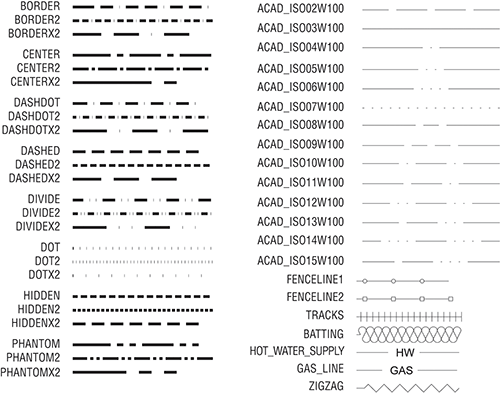
Adding a Linetype to a Drawing
To see how linetypes work, you’ll add a DASHDOT line in the bathroom plan to indicate a shower curtain rod:
1. In the Layers palette, click the plus icon in the lower-left corner to create a new layer, and then type Pole↵ to give the new layer a unique name.
2. Select the Pole layer in the list, and then in the Properties Inspector palette, click the Linetype option to open the pop-up menu.
If you’re in a hurry, you can simultaneously load a linetype and assign it to a layer by using the Layer command. In this exercise, you enter -Layer↵ at the Command prompt. Then enter L↵, DASHDOT↵, and pole↵, and press ↵ to exit the Layer command.
3. Select Manage from the pop-up list. The Select Linetype dialog box appears (see Figure 5-20).
4. The Select Linetype dialog box offers a list of linetypes to choose from. In a new file such as the Bath file, only one linetype is available by default. You must load any additional linetypes you want to use. Click the Load button at the bottom of the dialog box to open the Load Or Reload Linetypes dialog box. You can sort the names alphabetically or by description by clicking the Linetype or Description heading at the top of the list (see Figure 5-21).
Figure 5-20:The Select Linetype dialog box

Figure 5-21:The Load Or Reload Linetypes dialog box
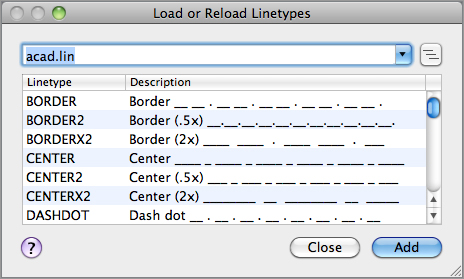
5. In the list of linetypes, scroll down to locate the DASHDOT linetype, click it, and then click Add.
6. Notice that the DASHDOT linetype is added to the linetypes available in the Select Linetype dialog box.
7. Click DASHDOT to highlight it; then click OK. DASHDOT appears in the Linetype option in the Properties Inspector palette.
8. Back in the Layers palette, make sure Pole is still highlighted, and then right-click and select Set Current from the shortcut menu.
9. Turn off Object Snap mode; then, draw a line representing the shower curtain rod across the opening of the tub area as shown later in Figure 5-23.
Controlling Linetype Scale
Although you’ve designated this as a DASHDOT line, it appears solid. Zoom in to a small part of the line and you’ll see that the line is indeed as you specified.
Because your current drawing is at a scale of 1˝ = 1´, you must adjust the scale of your linetypes accordingly. This is accomplished in the Linetype Manager dialog. Here are the steps:
1. Choose Format Linetype from the menu bar. You can also enter LT↵. The Linetype Manager dialog box opens (see Figure 5-22).
Figure 5-22:The Linetype Manager dialog box
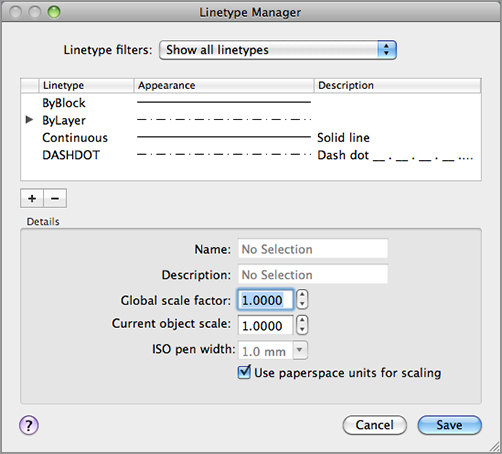
The Linetype Manager dialog box offers plus and minus buttons below the Linetypes list that let you load or delete a linetype directly without having to go through a particular layer’s linetype setting.
2. Double-click the Global Scale Factor text box, and then type 12 (metric users type 30). This is the scale conversion factor for a 1˝ = 1´ scale. (See the section “Understanding Scale Factors” in Chapter 3, “Setting Up and Using AutoCAD’s Drafting Tools.”)
3. Click Save. The shower curtain rod is displayed in the linetype and at the scale you designated.
4. Choose View Zoom All or type Z↵ A↵ so your drawing looks like Figure 5-23.
You can also use the Ltscale system variable to set the linetype scale. Type LTS↵, and at the Enter new linetype scale factor <1.0000>: prompt, enter 12↵.
Figure 5-23:The completed bathroom
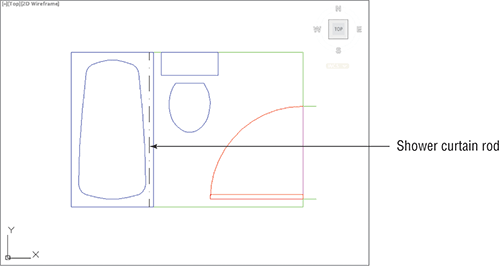
Linetypes Troubleshooting
If you change the linetype of a layer or an object but the object remains a continuous line, check the Ltscale system variable. It should be set to your drawing scale factor. If this doesn’t work, set the Viewres system variable to a higher value (see Appendix D on the book’s companion website). (Viewres can also be set by the Arc And Circle Smoothness option in the Document Settings option of the Application Preferences dialog box.) The behavior of linetype scales depends on whether you’re in Model Space or in a drawing layout. If your efforts to control linetype scale have no effect on your linetype’s visibility, you may be in a drawing layout. See Chapter 15 for more on Model Space and layouts.
Remember that if you assign a linetype to a layer, everything you draw on that layer will be of that linetype. This includes arcs, polylines, circles, and traces. As explained in the sidebar “Assigning Colors, Linetypes, and Linetype Scales to Individual Objects” later in this chapter, you can also assign different colors and linetypes to individual objects rather than relying on their layer assignment to define color and linetype. However, you may want to avoid assigning colors and linetypes directly to objects until you have some experience with AutoCAD and a good grasp of your drawing’s organization.
In the previous exercise, you changed the global linetype scale setting. This affects all noncontinuous linetypes within the current drawing. You can also set the default linetype scale for all new objects with the Celtscale system variable (type CELTSCALE↵ and enter the desired scale factor).
When individual objects are assigned a linetype scale, they’re still affected by the global linetype scale set by the Ltscale system variable. For example, say you assign a linetype scale of 2 to the curtain rod in the previous example. This scale is then multiplied by the global linetype scale of 12, for a final linetype scale of 24.
You can also set the default linetype scale for individual objects by using the Celtscale system variable. After it’s set, only newly created objects are affected. You must use the Properties Inspector palette to change the linetype scale of individual existing objects.
Linetypes in Layouts
A system variable called Psltscale affects how layout viewports display linetypes. When the Psltscale system variable is set to 1, layout viewports display linetypes at the Ltscale setting, which is usually incorrect for the 1-to-1 scale of the layout. When Psltscale is set to 0, linetypes appear in layout viewports in the same way they appear in the Model Space.
Adding the Final Detail
If you’re working through the tutorial, your final task is to set up an insertion point for the current drawing to facilitate its insertion into other drawings in the future. Follow these steps:
1. Type BASE↵.
2. At the Enter base point <0´-0˝,0´-0˝,0´-0˝>: prompt, use the Endpoint object snap to pick the upper-left corner of the bathroom. The bathroom drawing is complete.
3. Choose File Save to save the current drawing.
Controlling Line Weights
You may have noticed a Lineweight option in the Properties Inspector palette. If you click this option for a given layer or object, a pop-up list that enables you to control the plotted thickness of your lines appears. Plotted line weights can be assigned directly to an object or to layers. You can view line weights as they will appear in your final plot by making setting changes in the Lineweights Settings dialog box, which you’ll learn about in Chapter 15.
With the Lineweight option and Lineweight Settings dialog box, you have greater control over the look of your drawings. This can save time because you don’t have to print your drawing just to check for line weights. You’ll be able to see how thick or thin your lines are as you edit your drawing.
Using Objects to Control Layers
You’ve seen the various tools used to control the layers in a drawing. AutoCAD also offers a set of icons that can help streamline many of the layer operations. You may have already noticed the row of icons at the top of the Layers palette. These icons enable you to set layer properties through the objects in your drawing.
For example, suppose you want to turn off the layer of a particular object in the drawing. You can select the object and then check the Properties Inspector palette to find its layer. Once you know the layer name, you can turn it off. But the Turn Off Object’s Layer icon in the Layers palette turns off an object’s layer with a single click, saving a few steps.
Figure 5-24 shows you the tooltip name of each icon and Table 5-2 describes how each tool is used. Keep these icons in mind as you work with AutoCAD. You’ll find they can be real timesavers.
Figure 5-24:The Layers palette icons

Table 5-2: The Layers palette icons
| Icon Name | Use |
| Make Object’s Layer Current | Click this icon, and then select an object to make its layer current. |
| Match Layer | Click this icon, select an object or objects whose layer assignment you want to change, press ↵, and then select an object whose layer you want to change to. |
| Previous Layer | Click this icon to switch to the previous current layer. |
| Isolate Object’s Layer | Click this icon, and then select an object to turn off all layers except the selected object’s layer. |
| Unisolate Objects Layer | Click this option to undo the action of the Isolate Object’s Layer icon. |
| Freeze Object’s Layer | Click this icon, and then select an object to freeze its layer. |
| Turn Off Object’s Layer | Click this icon, and then select an object to turn off its layer. |
| Lock Object”s Layer | Click this icon, and then select an object to lock its layer. |
| Unlock Object’s Layer | Click this icon, and then select an object to unlock its layer. |
Keeping Track of Blocks and Layers
The Insert Block dialog box and the Layers palette let you view the blocks and layers available in your drawing by listing them in a window. The Layers palette also includes information about the status of layers. However, you may forget the layer on which an object resides. You’ve seen how the Properties Inspector palette shows you the properties of an object or layer. The List option menu bar also enables you to get information about individual objects.
Use these steps to see an alternate way to view the properties of a block:
1. Choose Tools Inquiry List. You can also type LIST↵.
2. At the Select objects: prompt, click the Tub block, and then press ↵.
3. In the Command Line palette, a listing appears that shows not only the layer the tub is on, but also its space, insertion point, name, rotation angle, and scale. You may need to expand the Command Line palette to view the information (click the disclosure triangle on the right side of the palette).
The information in the Command Line palette, except the handle listing, is duplicated in the Properties Inspector palette when you select an object. But having the data in the Command Line palette gives you the flexibility to record it in a text file in case you need to store data about parts of your drawing. You can also use the Command Line palette to access and store other types of data regarding your drawings.
The Space property listed for the Tub block designates whether the object resides in Model Space or Paper Space. You’ll learn more about these spaces in Chapters 8 and 15.
Getting a Text File List of Layers or Blocks
With complex drawings, it can be helpful to get a text file that lists the layers or blocks in your drawing. You can do this by using the log-file feature in AutoCAD. At the Command prompt, enter LOGFILEMODE↵, and then enter 1↵. Type -LA↵ ?↵↵ (don’t forget the minus sign at the beginning of the LA command). Your list of layers appears in the Command Line palette. For a list of blocks, enter -Insert↵ ?↵↵. When you’ve obtained your list, close the log-file feature by typing LOGFILEMODE↵ 0↵.
Once the log-file feature is closed, you can use any text editor to open the AutoCAD log. To find the location of the log file, enter LOGFILENAME↵. The name and location of the log file appears in the Command Line palette. Typically, the location would look similar to the following:
/Users/user name/Library/Application Support/
Autodesk/local/AutoCAD Mac/R18.1/English/
The log file may be in a hidden folder, but you can get to it using the Go To Folder command. While in Finder, press ![]() -F-G. In the Go To Folder dialog box, enter the location of the log file, and click Go.
-F-G. In the Go To Folder dialog box, enter the location of the log file, and click Go.
With the log-file feature, you can record virtually anything that appears at the Command prompt. You can even record an entire AutoCAD session. The log file can also be helpful in constructing script files to automate tasks. (See Bonus Chapter 1 on the book’s companion website for more information on scripts.) If you want a hard copy of the log file, print it from an application such as TextEdit or your favorite word processor.
Assigning Colors, Linetypes, and Linetype Scales to Individual Objects
If you prefer, you can set up AutoCAD to assign specific colors and linetypes to objects instead of having objects take on the color and linetype settings of the layer on which they reside. Normally, objects are given a default color and linetype called ByLayer, which means each object takes on the color or linetype of its assigned layer. (You’ve probably noticed the word ByLayer in the Properties Inspector palette and in various dialog boxes.)
Use the Properties Inspector palette to change the color or linetype of existing objects. For new objects, choose Format Color or enter COLOR↵ to open the Color Palette dialog box. This enables you to set the current default color to red (for example) instead of ByLayer. Then everything you draw will be red regardless of the current layer color.
For linetypes, you can use the Linetype Manager (Format Linetype) to select a default linetype for all new objects. To set the default linetype in the Linetype Manager, double-click on the linetype name so that the “current” triangle to the far left points to the linetype. The list in the Linetype Manager shows only linetypes that have already been loaded into the drawing, so if a desired linetype does not appear in the list, you must use the Load icon (plus sign) to load additional linetypes.
Another possible color and linetype assignment is ByBlock, which you also set with the Properties Inspector palette. ByBlock color makes everything you draw white until you turn your drawing into a block and then insert the block on a layer with an assigned color. The objects then take on the color of that layer. This behavior is similar to that of objects drawn on layer 0. The ByBlock linetype and the ByBlock color work similarly.
Finally, if you want to set the linetype scale for each individual object instead of relying on the global linetype scale (the Ltscale system variable), you can use the Properties Inspector palette to modify the linetype scale of individual objects. In place of using the Properties Inspector palette, you can set the Celtscale system variable to the linetype scale you want for new objects.
As mentioned earlier, stay away from assigning colors and linetypes to individual objects until you’re comfortable with AutoCAD; even then, use color and linetype assignments carefully. Other users who work on your drawing may have difficulty understanding your drawing’s organization if you assign color and linetype properties indiscriminately.
Organize information with layers. Layers are perhaps the most powerful feature in AutoCAD. They help to keep drawings well organized, and they give you control over the visibility of objects. They also let you control the appearance of your drawing by setting colors, line weights, and linetypes.
Master It Describe the process of creating a layer.
Control layer visibility. When a drawing becomes dense with information, it can be difficult to edit. If you’ve organized your drawing using layers, you can reduce its complexity by turning off layers that aren’t important to your current session.
Master It Describe two methods for hiding a layer.
Keep track of blocks and layers. At times, you may want a record of the layers or blocks in your drawing. You can create a list of layers using the log-file feature in AutoCAD.
Master It How do you turn on the log-file feature?
